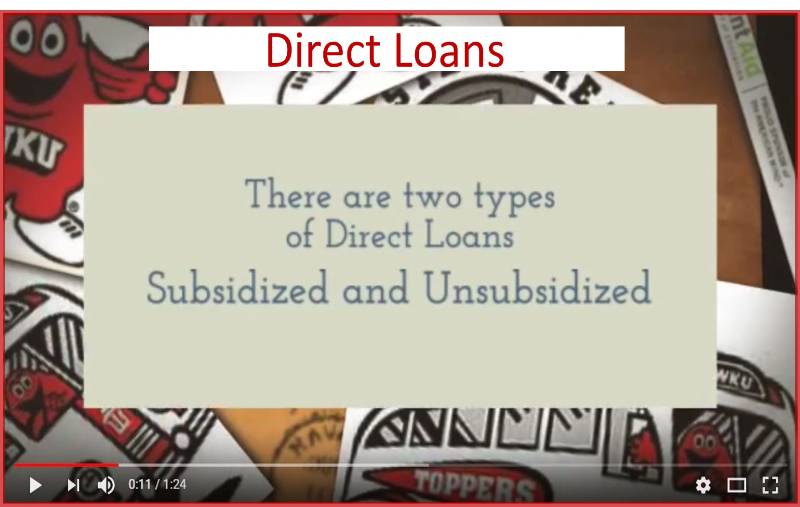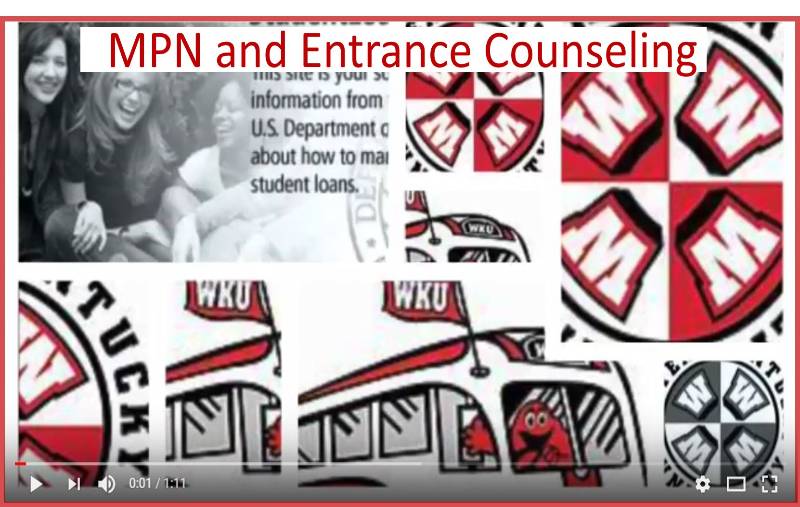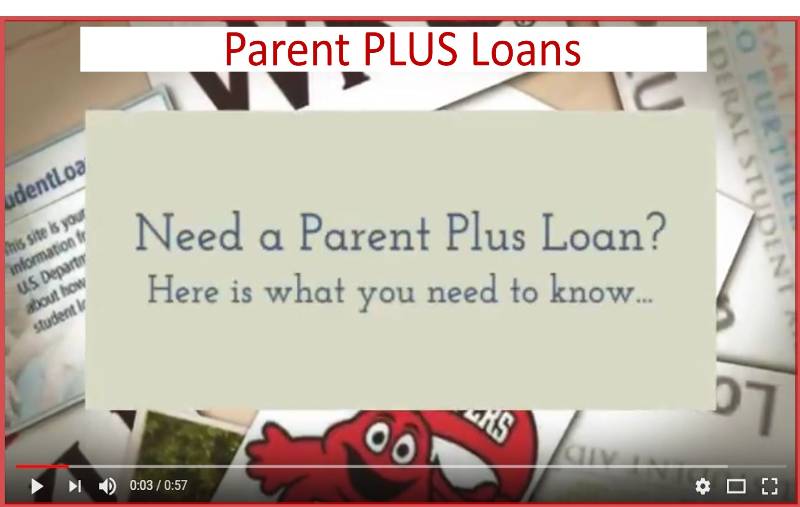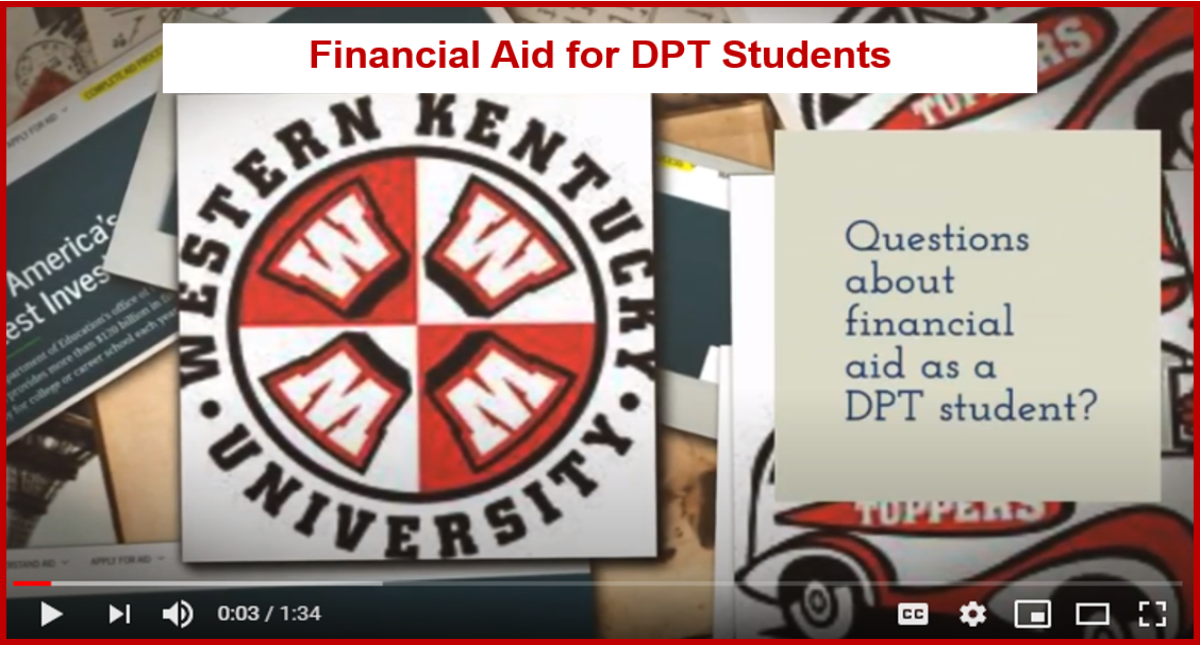Loans
The information below provides information about federal student loans and private loans. Federal student loans are loans that are funded by the federal government, such as Direct Subsidized Loans and Direct Unsubsidized Loans. Private loans are nonfederal loans that are made by a lender, such as a bank, credit union, or state agency.
Click on a question below for the answer. Click on the question again to close.
Borrow only what is absolutely necessary! The less you borrow now, the less you will have to pay back later.
Students must complete the FAFSA (Free Application for Federal Student Aid) to determine their eligibility for a federal student loan. The form is found online at www.StudentAid.gov. In about three to four weeks, WKU will receive information from the federal processing center, which will determine what type of loan eligibility the student may have. (Subsidized, Unsubsidized or both). Once all financial aid requirements have been met, the student should receive an Award Notification via email that indicates how much they are eligible to borrow for the academic year.
Students must accept their loans through their TopNet account. Before any loan funds can be disbursed, all first-time borrowers must complete the Entrance Loan Counseling session, e-sign a Master Promissory Note (MPN), and complete the Annual Student Loan Acknowledgment (ASLA). Students can access these three steps by logging in with their FSA ID at studentaid.gov.
**NOTE** If the student does not complete ALL 4 steps, the loan will never go through**
These 4 steps are:
- Accept desired amount of loan through their TopNet
- Successfully complete their Entrance Loan Counseling session at studentaid.gov
- Successfully e- sign their Master Promissory Note (MPN) at studentaid.gov
Subsidized and unsubsidized loans are federal student loans for eligible students to help cover the cost of higher education at a four-year college or university, community college, or trade, career, or technical school. The U.S. Department of Education offers eligible students at participating schools Direct Subsidized Loans and Direct Unsubsidized Loans. (Some people refer to these loans as Stafford Loans or Direct Stafford Loans.)
In short, Direct Subsidized Loans have slightly better terms to help out students with financial need .
Direct Subsidized Loans:
- Direct Subsidized Loans are available to undergraduate students with financial need.
- The school determines the amount you can borrow, and the amount may not exceed your financial need.
- The U.S. Department of Education pays the interest on a Direct Subsidized Loan:
- while the student is enrolled in school at least half-time,
- for the first six months after a student leaves school (referred to as a grace period*), and
- during a period of deferment (a postponement of loan payments).
*Note: If a student received a Direct Subsidized Loan that was first disbursed between July 1, 2012, and July 1, 2014, he/she will be responsible for paying any interest that accrues during the grace period. If he/she chooses not to pay the interest that accrues during the grace period, the interest will be added to the principal balance.
Unsubsidized Loans:
- Direct Unsubsidized Loans are available to undergraduate and graduate students; there is no requirement to demonstrate financial need.
- The school determines the amount a student can borrow based on the student’s cost of attendance and other financial aid he/she receives.
- The student is responsible for paying the interest on a Direct Unsubsidized Loan during all periods.
- If the student chooses not to pay the interest while in school and during grace periods and deferment or forbearance periods, the interest will accrue (accumulate) and be capitalized (that is, the interest will be added to the principal amount of the loan).
Your school determines the loan type(s), if any, and the actual loan amount you are eligible to receive each academic year. However, there are limits on the amount in subsidized and unsubsidized loans that you may be eligible to receive each academic year (annual loan limits) and the total amounts that you may borrow for undergraduate and graduate study (aggregate loan limits). The actual loan amount you are eligible to receive each academic year may be less than the annual loan limit. These limits vary depending on:
- what year you are in school and
- whether you are a dependent or independent student.
Dependent students whose parents are ineligible for a Direct PLUS Loan, may be able to receive additional Direct Unsubsidized Loan funds.
The following chart shows the annual and aggregate limits for subsidized and unsubsidized loans.
|
Year |
Dependent Students (except students whose parents are unable to obtain PLUS Loans) |
Independent Students (and dependent undergraduate students whose parents are unable to obtain PLUS Loans) |
|---|---|---|
|
First-Year Undergraduate Annual Loan Limit |
$5,500—No more than $3,500 of this amount may be in subsidized loans. |
$9,500—No more than $3,500 of this amount may be in subsidized loans. |
|
Second-Year Undergraduate Annual Loan Limit |
$6,500—No more than $4,500 of this amount may be in subsidized loans. |
$10,500—No more than $4,500 of this amount may be in subsidized loans. |
|
Third-Year and Beyond Undergraduate Annual Loan Limit |
$7,500—No more than $5,500 of this amount may be in subsidized loans. |
$12,500—No more than $5,500 of this amount may be in subsidized loans. |
|
Graduate or Professional Students Annual Loan Limit |
Not Applicable (all graduate and professional students are considered independent) |
$20,500 (unsubsidized only) |
|
Subsidized and Unsubsidized Aggregate Loan Limit |
$31,000—No more than $23,000 of this amount may be in subsidized loans. |
$57,500 for undergraduates—No more than $23,000 of this amount may be in subsidized loans. $138,500 for graduate or professional students—No more than $65,500 of this amount may be in subsidized loans. The graduate aggregate limit includes all federal loans received for undergraduate study. |
Notes:
- The aggregate loan limits include any Subsidized Federal Stafford Loans or Unsubsidized Federal Stafford Loans the student may have previously received under the Federal Family Education Loan (FFEL) Program. As a result of legislation that took effect July 1, 2010, no further loans are being made under the FFEL Program.
- Effective for periods of enrollment beginning on or after July 1, 2012, graduate and professional students are no longer eligible to receive Direct Subsidized Loans. The $65,500 subsidized aggregate loan limit for graduate or professional students includes subsidized loans that a graduate or professional student may have received for periods of enrollment that began before July 1, 2012, or for prior undergraduate study.
If the total loan amount a student receives over the course of his/her education reaches the aggregate loan limit, the student is not eligible to receive additional loans. However, if the student repays some of the loans to bring the outstanding loan debt below the aggregate loan limit, the student could then borrow again, up to the amount of their remaining eligibility under the aggregate loan limit.
The interest rates for Direct Subsidized Loans and Direct Unsubsidized Loans are shown in the chart below.
|
Loan Type |
Borrower Type |
Loans first disbursed on or after 7/1/22 |
|---|---|---|
|
Direct Subsidized Loans |
Undergraduate |
4.99% |
|
Direct Unsubsidized Loans |
Undergraduate |
4.99% |
|
Direct Unsubsidized Loans |
Graduate or Professional |
6.54% |
The interest rates shown above are fixed rates for the life of the loan.
Have other questions about interest?
- Understanding interest rates and fees—Find out how interest is calculated.
- Information for military members—If you are a member of the military, you may be eligible for special interest benefits relating to your federal student loans.
- Additional Information—More information about interest rates can be found at www.StudentAid.gov.
Yes, a loan fee, called origination, is assessed on all Direct Subsidized Loans and Direct Unsubsidized Loans. The loan fee is a percentage of the loan amount and is proportionately deducted from each loan disbursement. The percentage varies depending on when the loan is first disbursed, as shown in the chart below.
|
Loan Fees for Direct Subsidized Loans and Direct Unsubsidized Loans |
|
|---|---|
|
First Disbursement Date |
Loan Fee |
|
On or after Oct. 1, 2020, and before Oct. 1, 2021 |
1.057% |
|
On or after Oct. 1, 2019, and before Oct. 1, 2020 |
1.059% |
Undergraduate students must be enrolled in at least 6 undergraduate hours (400 level or below classes) and graduate students must be enrolled in at least 4.5 graduate hours (500 level or above classes) to be eligible for Direct Loans. Enrollment will be verified at the end of the first week of classes.
To receive a Stafford Loan, you must have a valid Direct Loan Master Promissory Note (MPN) on file with the U.S. Department of Education and have satisfied Stafford Loan Entrance Counseling requirements. Both the Direct Loan Master Promissory Note and Stafford Loan Entrance Counseling requirements may be satisfied online at www.StudentAid.gov. Also, beginning with the 2021-2022 academic year, all borrowers will be required to complete the Annual Student Loan Acknowledgment (ASLA) counseling that can be found at www.StudentAid.gov. The ASLA must be completed each academic year.
No, parents are not responsible for paying back a student loan that is in the student’s name. Parents are, however, responsible for paying back any Federal PLUS loans they chose to borrow. Parents will only be responsible for a student’s educational loan if they co-sign a private loan for the student. In general, the student is solely responsible for repaying his/her educational loans.
Students do not need their parents to cosign for a Direct Student loan, even if the student under age 18, because the ‘defense of infancy’ does not apply to federal student loans. (The defense of infancy presumes that a minor is not able to enter into contracts and considers any such contract to be void. The Higher Education Act includes an explicit exemption to this principle with regard to federal student loans.) However, lenders may require a cosigner on private student loans if the student's credit history is insufficient or if they are underage. In fact, many private student loan programs are not available to students under age 18 because of the defense of infancy.
If students want to reduce the amount of student loan they accepted on TopNet, they will simply submit an email to fa.loans@wku.edu and indicate how much they would like to reduce the loan by AND the total amount they wish to borrow. Please allow at least 3 to 5 business days for the reduction to be completed.
Students’ Award Notifications will include the maximum amount of federal loans they may be eligible for at that time. If the student’s FAFSA information or other educational information changes, his/her loan eligibility may increase or decrease.
If the student's grade level increases, he/she may be eligible to receive additional funding. The student can send an email to fa.loans@wku.edu to request this increase. There may only be an increase if a student is going from a freshman to sophomore or a sophomore to a junior. Juniors and seniors are eligible for the same yearly amount, so no increase is applicable.
You might be eligible for more Direct Student loans. Once your Fall/Spring grades have been posted, if your grade level has increased from a Freshman level to a Sophomore level (30 credit hours earned) or has changed from the Sophomore level to a Junior level (60 credit hours earned), you may be eligible for more Direct Student loan funds. This depends on your Cost of Attendance and the amount of your initial financial aid award.
If you would like your eligibility for a loan increase to be reviewed, send an email message to fa.loans@wku.edu with your specific request. If you are eligible, the loan amount will be increased, and you will receive a disbursement as scheduled. (A new loan application is not needed). Direct Loans will mail a disclosure statement to you reflecting the increased award.
Yes, you can reject all or part of your loan. It will not affect the loan amount that you are offered for the next academic year.
Students must complete the Exit Counseling requirement if any of the following apply: enrollment falls below half-time status (6 credit hours for undergraduate students, 4.5 credit hours for graduate students) or the student withdraws or graduates. To complete Exit Counseling, go to www.StudentAid.gov, click on Exit Counseling under the Tools and Resources section on the front page, and follow the instructions.
Cosigners can be used to help secure a private loan, but are not always necessary. If the student does not have a long credit history or does not have good credit, having a cosigner may help him/her get approved for a private loan or get a better interest rate. If the student decides a cosigner is needed, make sure that person(s) understands and accepts his/her responsibility as one. Cosigners are as responsible for paying the loan as the borrower is. Talk to your lender for more information.
In order to cancel your student loans for the current semester, you will need to send an email to fa.loans@wku.edu from your TopperMail email address. Once our office receives your email, we can then cancel the funds and return them to the lender.
In the body of your email, please include a specific loan amount that you would like to have canceled OR request for the full loan amount to be canceled. If you have already received a residual, you will be responsible for paying that back to the lender.
Private loans are nonfederal loans offered by a lender. The approval of the loan may depend on the borrower’s credit history. For more information about the difference between federal and nonfederal loans, visit the Federal Student Aid website.
Multiple lenders offer private loans, and students are free to apply for a loan with any lender they prefer. For more information about private loans, click here . This link redirects you to Fast Choice’s website, which will provide information about private loans in an easy-to-understand format.
Attention December Graduates : If you do not graduate in December, you will need to update your graduation date with the Registrar’s office and send an email to fa.loans@wku.edu if you would like to borrow a loan for the Spring semester. In the email, include your WKU ID and the total amount you would like to borrow for the semester.
For more information about loans, visit our FAQ section on our website.
Borrow only what is absolutely necessary!
Students must complete the FAFSA (Free Application for Federal Student Aid) to determine their eligibility for a federal student loan. The form is found online at www.StudentAid.gov. In about three to four weeks, WKU will receive information from the federal processing center, which will determine what type of loan eligibility the student may have. (Subsidized, Unsubsidized or both). Once all financial aid requirements have been met, the student should receive an Award Notification via email that indicates how much they are eligible to borrow for the academic year.
Students must accept their loans through their TopNet account. Before any loan funds can be disbursed, all first-time borrowers must complete the Entrance Loan Counseling session, e-sign a Master Promissory Note (MPN) and, complete the Annual Student Loan Acknowledgment (ASLA)*. Students can access these three steps by logging in with their FSA ID at www.StudentAid.gov.
Master Promissory Notes (MPN) are good for 10 years. If a graduate student already has an MPN on file from his/her undergraduate degree, a new MPN will not need to be signed unless it has expired due to the 10-year limit. If it has expired, the student will need to go back to www.StudentAid.gov and sign a new MPN.
Graduate students may be eligible to borrow Direct Unsubsidized Loans; however, they are not eligible to borrow Direct Subsidized Loans.
Here’s a quick overview of Direct Unsubsidized Loans:
- Direct Unsubsidized Loans are available to undergraduate and graduate students; there is no requirement to demonstrate financial need.
- The school determines the amount a student can borrow based on the student’s cost of attendance and other financial aid he/she receives.
- The student is responsible for paying the interest on a Direct Unsubsidized Loan during all periods.
- If the student chooses not to pay the interest while in school and during grace periods and deferment or forbearance periods, the interest will accrue (accumulate) and be capitalized (that is, the interest will be added to the principal amount of the loan).
Graduate students must be enrolled in a minimum of 4.5 credit hours to borrow a Direct Unsubsidized Loan.
Generally, graduate students can borrow up to $20,500 per academic year in Direct Unsubsidized Loans.
Students cannot borrow over the aggregate limit of $138,500 in Direct Unsubsidized Loans.
The current interest rate for Direct Unsubsidized Loans is 6.54%.*
*Note: Interest rate for Direct Loans first disbursed on or after July 1, 2022.
If students need to borrow more than what they have been offered in Direct Unsubsidized Loans, they may apply for a Graduate PLUS loan at www.StudentAid.gov
Graduate PLUS loans are subject to credit approval, and an additional Master Promissory Note (MPN) must be signed for that PLUS loan.
PLUS loans can generally be awarded up to the student's cost of attendance, if approved for that much.
The interest rate for the Graduate PLUS loan is currently:
7.54% for loans disbursed on or after July 1, 2022
The loan fee for the Graduate PLUS loan is currently:
4.228% for loans disbursed on or after Oct. 1, 2020, and before Oct. 1, 2021.
Students are encouraged to regularly log in at www.StudentAid.gov to monitor their loan balances.
All students are required to complete Exit Counseling when they cease to be enrolled in at least 4.5 hours. Exit Counseling will give helpful information when students go into repayment, such as specifics on the type of repayment plans they may be eligible for.
In order to cancel your student loans for the current semester, you will need to send an email to fa.loans@wku.edu from your TopperMail email address. Once our office receives your email, we can then cancel the funds and return them to the lender.
In the body of your email, please include a specific loan amount that you would like to have canceled OR request for the full loan amount to be canceled. If you have already received a residual, you will be responsible for paying that back to the lender.
Private loans are nonfederal loans offered by a lender. Approval of the loan may depend on the borrower’s credit history. For more information about the difference between federal and nonfederal loans, visit the Federal Student Aid website.
Multiple lenders offer private loans, and students are free to apply for a loan with any lender they prefer. For more information about private loans, click here . This link redirects you to Fast Choice’s website, which will provide information about private loans in an easy-to-understand format.
The PLUS loan is a loan that the parent can apply for to help cover expenses for college.
The biological, adoptive, or step-parent, whose information is listed on the student's FAFSA, can apply for the PLUS loan.
No, the parent MUST be the one to apply for this loan. The student is not permitted to fill it out for the parent. This is a legal document.+
No, the student must have a FAFSA on file before the parent can borrow a PLUS loan.
The parent for whom the loan is approved will be responsible for paying back the loan.
-
Go to fsaid.ed.gov to apply for your personal FSA ID. You will need this to log into the Federal Student Aid system to apply for the PLUS loan.
-
Go to www.StudentAid.gov
-
Click on the white Log In button then log in using your log in information, NOT the student's information.
-
Click on Apply for a PLUS Loan
-
If you are approved for the PLUS loan and wish to borrow the loan, you MUST sign the Master Promissory Note (MPN), or the loan will never go through.
Helpful Hints
-
Be certain that you list your information as the borrower and your student’s information as the student . Mixing up these two will cause the application to be invalid.
-
Be certain that you report the correct name, social security number, and date of birth for your student, or your PLUS loan may not link to your student's account.
-
Remember, if you are going to request a specific amount for your loan rather than the maximum amount, the total amount requested will be split evenly between the Fall and Spring semester. So if you need $5,000 for each semester, be sure to request $10,000, so you will have $5,000 per semester.
-
The lender will deduct an origination fee of *4.228 from the total loan amount requested.
-
If you are the student, you cannot apply for a Parent PLUS loan in your parent/step-parent's name. Doing so will constitute fraud.
*Note: Origination fee for Parent PLUS loans disbursed on or after Oct. 1, 2020, and before Oct. 1, 2021.
No, PLUS loan approval depends on the borrower's credit history.
Yes, parents can either apply for the maximum amount or request a specific amount.
**Please note: the amount requested will be split evenly between the Fall and Spring semesters. For example, if $5,000 is needed for Fall, request $10,000. That way $5,000 will be applied in the Fall and $5,000 applied in the Spring.
No, parents can request that the loan payments be deferred while the student is in school. However, interest begins to accrue once the loan has been disbursed.
No, if the parent does not want to borrow the approved PLUS loan, he/she will simply not sign their Master Promissory Note (MPN), and the loan will never be processed.
If the parent is not approved, WKU will be notified of the denial, and the student will automatically be awarded an additional $2,000 per semester in an unsubsidized loan.
Note: if the parent wants to try to be approved, he/she can attempt to reapply with an endorser. If approved with an endorser, the parent must complete the PLUS Credit Counseling.
The current interest rate for the PLUS loan is 7.54%.*
*Note: Interest rate for Direct Loans first disbursed on or after July 1, 2022.
Parents will need to re-apply for the PLUS loan each academic year.
Private loans are nonfederal loans offered by a lender. The approval of the loan may depend on the borrower’s credit history. For more information about the difference between federal and nonfederal loans, visit the Federal Student Aid website.
Multiple lenders offer private loans, and students are free to apply for a loan with
any lender they prefer. For more information about private loans, click here. This link redirects you to Fast Choice’s website, which will provide information about private loans in an easy-to-understand
format.
Due to the nature of the Doctor of Physical Therapy (DPT) graduate program, both direct and indirect costs are taken into consideration with regard to funding a student’s education. At this time, loans are the sole funding option for DPT students. We encourage students to borrow responsibly while maintaining a reasonable living standard and meeting their educational expenses. Below are several points of interest to make funding your education a smooth process.
All DPT students have a standardized Cost of Attendance (COA), also referred to as a budget, which is used to determine the maximum loan amount a student may borrow each year. The budget allows for direct educational costs associated with the program, such as tuition, fees, books, and so on. Indirect costs like room and board, travel, and miscellaneous personal expenses are also considered in the total budget amount. Your specific COA information is viewable on TopNet for each period of enrollment.
Students in unique situations, including international students and those with dependent childcare expenses, should contact Bryson Davis at bryson.davis@wku.edu for a Cost of Attendance review. Mr. Davis will determine whether any additional expenses may be considered in the total COA.
WKU graduate students with valid FAFSAs on file, who are enrolled at least half-time and have no outstanding financial aid requirements, are generally eligible to borrow Direct Unsubsidized Student Loans (Stafford loans) up to *$20,500 per academic year. Information regarding interest rates and other loan basics is available at www.StudentAid.gov . Direct Loans have a fixed interest rate and are loaned to the student by the federal government with no credit check; however, interest begins accruing at the time of disbursement and continues until the loan is paid in full.
(*Annual loan eligibility is reviewed in accordance with federal guidelines; students who fail to meet those guidelines, such as those in default on a student loan or who have reached the maximum aggregate loan limit, may no longer be eligible for federal loans).
After borrowing the maximum Stafford loan for the academic year, students needing additional funds may wish to apply for a Graduate PLUS loan. Similar to Direct Student Loans, Graduate PLUS loans have a fixed interest rate and are loaned to the student by the federal government. However, approval is based on the student’s credit rating. If approved, the student can borrow the remaining eligibility not already met by the Stafford loan, up to the total Cost of Attendance for that year. For example, a student who borrowed $20, 500 in Stafford loan and has an annual COA of $48,200 can borrow a Graduate PLUS loan up to $27,700. Additional information about Graduate PLUS loans is available at www.StudentAid.gov.
Private loans, also called alternative loans, are available through several lenders not associated with the federal government. Interest rates and loan product options vary by lender, and approvals are based on the student’s credit rating. The lender may require a cosigner before approving a student’s loan application.
To make the wisest borrowing decision, we urge WKU students to compare the various Private Loan options with the Graduate PLUS loan offered by the federal government. Always consider interest rates and repayment options when determining the best loan product for your educational needs. For more information about private (or alternative) loans, click here. This link redirects you to Fast Choice’s website, which will provide information about private loans in an easy-to-understand format.
Further questions about Alternative Loans can be directed to fa.loans@wku.edu.
The goal of the WKU Department of Student Financial Assistance is to assist all students in the most efficient manner possible with regards to funding their educational endeavors. If you have general questions regarding your financial aid, such as verification or additional information being requested, you can send an email to fa.help@wku.edu. If you have questions regarding your loan, please send an email to kati.wherry@wku.edu. Please include DPT in the subject line of your email and provide your WKU ID number in the body of the email.
Watch Financial Aid Videos
Student Financial Assistance
317 Potter HallWestern Kentucky University
1906 College Heights Blvd. #11018
Bowling Green, KY 42101-1018
Phone: 270-745-2755
Fax: 270-745-6586
Email: fa.help@wku.edu
Some of the links on this page may require additional software to view.






